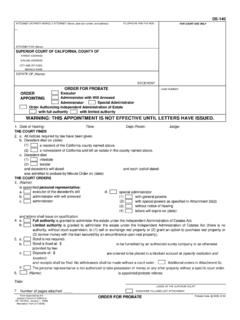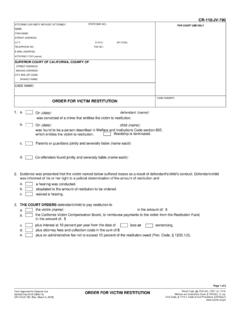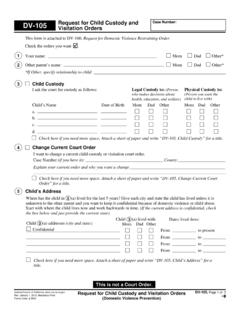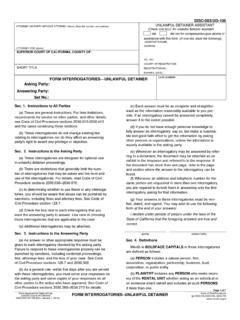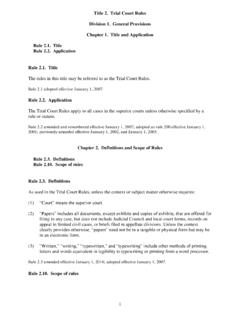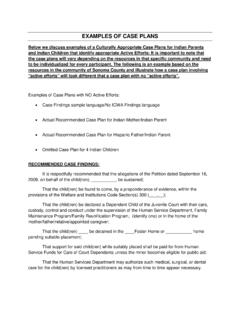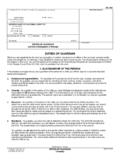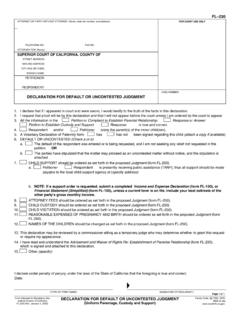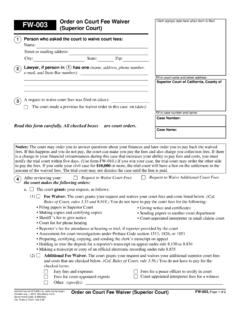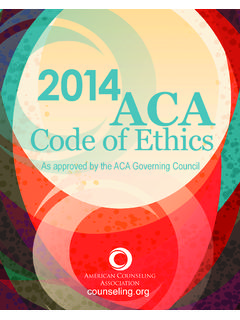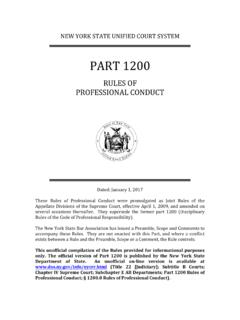Transcription of 1 CALIFORNIA CODE OF JUDICIAL ETHICS 2 3
1 1 CALIFORNIA code OF JUDICIAL ETHICS 1 2 Amended by the Supreme Court of CALIFORNIA effective December 1, 2016; adopted 3 effective January 15, 1996; previously amended March 4, 1999, December 13, 2000, 4 December 30, 2002, June 18, 2003, December 22, 2003, January 1, 2005, June 1, 2005, 5 July 1, 2006, January 1, 2007, January 1, 2008, April 29, 2009, January 1, 2013, January 6 21, 2015, and August 19, 2015. 7 8 Preface 9 10 Preamble 11 12 Terminology 13 14 Canon 1. A judge shall uphold the integrity and independence of the judiciary.
2 15 16 Canon 2. A judge shall avoid impropriety and the appearance of impropriety in all of 17 the judge s activities. 18 19 Canon 3. A judge shall perform the duties of JUDICIAL office impartially, competently, 20 and diligently. 21 22 Canon 4. A judge shall so conduct the judge s quasi- JUDICIAL and extrajudicial activities 23 as to minimize the risk of conflict with JUDICIAL obligations. 24 25 Canon 5. A judge or candidate for JUDICIAL office shall not engage in political or 26 campaign activity that is inconsistent with the independence, integrity, or impartiality 27 of the judiciary.
3 28 29 Canon 6. Compliance with the code of JUDICIAL ETHICS . 30 31 2 PREFACE 1 2 Formal standards of JUDICIAL conduct have existed for more than 65 years. The original 3 Canons of JUDICIAL ETHICS promulgated by the American Bar Association were modified 4 and adopted in 1949 for application in CALIFORNIA by the Conference of CALIFORNIA Judges 5 (now the CALIFORNIA Judges Association). 6 7 In 1969, the American Bar Association determined that then current needs and problems 8 warranted revision of the canons. In the revision process, a special American Bar 9 Association committee, headed by former CALIFORNIA Chief Justice Roger Traynor, sought 10 and considered the views of the bench and bar and other interested persons.
4 The 11 American Bar Association code of JUDICIAL conduct was adopted by the House of 12 Delegates of the American Bar Association August 16, 1972. 13 14 Effective January 5, 1975, the CALIFORNIA Judges Association adopted a new CALIFORNIA 15 code of JUDICIAL conduct adapted from the American Bar Association 1972 model code . 16 The CALIFORNIA code was recast in gender-neutral form in 1986. 17 18 In 1990, the American Bar Association model code was further revised after a lengthy 19 study. The CALIFORNIA Judges Association again reviewed the model code and adopted a 20 revised CALIFORNIA code of JUDICIAL conduct on October 5, 1992.
5 21 22 Proposition 190 (amending Cal. Const., art. VI, 18, subd. (m), operative March 1, 1995) 23 created a new constitutional provision that states, The Supreme Court shall make rules 24 for the conduct of judges, both on and off the bench, and for JUDICIAL candidates in the 25 conduct of their campaigns. These rules shall be referred to as the code of JUDICIAL 26 ETHICS . 27 28 The Supreme Court formally adopted the 1992 code of JUDICIAL conduct in March 1995, 29 as a transitional measure pending further review. 30 31 The Supreme Court formally adopted the code of JUDICIAL ETHICS effective January 15, 32 1996.
6 33 34 The Supreme Court has formally adopted amendments to the code of JUDICIAL ETHICS on 35 several occasions. The Advisory Committee Commentary is published by the Supreme 36 Court Advisory Committee on the code of JUDICIAL ETHICS . 37 38 3 PREAMBLE 1 2 Our legal system is based on the principle that an independent, fair, and competent 3 judiciary will interpret and apply the laws that govern us. The role of the judiciary is 4 central to American concepts of justice and the rule of law. Intrinsic to this code are the 5 precepts that judges, individually and collectively, must respect and honor the JUDICIAL 6 office as a public trust and must strive to enhance and maintain confidence in our legal 7 system.
7 The judge is an arbiter of facts and law for the resolution of disputes and is a 8 highly visible member of government under the rule of law. 9 10 The code of JUDICIAL ETHICS ( code ) establishes standards for ethical conduct of judges 11 on and off the bench and for candidates for JUDICIAL office.* The code consists of broad 12 declarations called canons, with subparts, and a terminology section. Following many 13 canons is a commentary section prepared by the Supreme Court Advisory Committee on 14 the code of JUDICIAL ETHICS . The commentary, by explanation and example, provides 15 guidance as to the purpose and meaning of the canons.
8 The commentary does not 16 constitute additional rules and should not be so construed. All members of the judiciary 17 must comply with the code . Compliance is required to preserve the integrity* of the 18 bench and to ensure the confidence of the public. 19 20 The canons should be read together as a whole, and each provision should be construed in 21 context and consistent with every other provision. They are to be applied in conformance 22 with constitutional requirements, statutes, other court rules, and decisional law. Nothing 23 in the code shall either impair the essential independence* of judges in making JUDICIAL 24 decisions or provide a separate basis for civil liability or criminal prosecution.
9 25 26 The code governs the conduct of judges and candidates for JUDICIAL office* and is binding 27 upon them. Whether disciplinary action is appropriate, and the degree of discipline to be 28 imposed, requires a reasoned application of the text and consideration of such factors as 29 the seriousness of the transgression, if there is a pattern of improper activity, and the 30 effect of the improper activity on others or on the JUDICIAL system. 31 32 4 TERMINOLOGY 1 2 Terms explained below are noted with an asterisk (*) in the canons where they appear.
10 In 3 addition, the canons in which these terms appear are cited after the explanation of each 4 term below. 5 6 Candidate for JUDICIAL office is a person seeking election to or retention of a JUDICIAL 7 office. A person becomes a candidate for JUDICIAL office as soon as he or she makes a 8 public announcement of candidacy, declares or files as a candidate with the election 9 authority, or authorizes solicitation or acceptance of contributions or support. See 10 Preamble and Canons 3E(2)(b)(i), 3E(3)(a), 5, 5A, 5A (Commentary), 5B(1), 5B(2), 11 5B(3), 5B (Commentary), 5C, 5D, and 6E.
